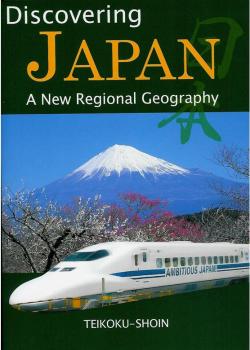Discovering Japan – A New Regional Geography

Teikoku Shoin Co. Ltd, Tokyo 2009, 152 pages including index, copiously illustrated with colour photographs and maps. ISBN 978-4-8071-5844-7, (available in the UK from JP-Books (JPT Europe Ltd.) 14-20 Regent Street, London SW1Y 4PH or bookstores in Japan) £29.80/¥ 1,995
Review by Sir Hugh Cortazzi
Kanasaka Kiyonori, who supervised the production of this book which was originally published in Japanese, is Professor of Geography at Kyoto University. The Preface explains that the book was originally published “with the aim of helping junior high school students in Japan to understand their country within the context of globalization.” The English translation is intended “to help foreigners who are working, residing or studying in Japan” or visiting the country “to gain a more accurate and deeper understanding of Japan that is not distorted by ill-informed prejudice or exoticism.”
The book is well produced and written without jargon. Part 1 starts with an overview of “the structure and nature of Japan” including geographical location and climate. This is followed by a short summary of the history of Japan which by its brevity avoids controversial issues. The third chapter in part I is headed “Various perspectives of Japan” and comments on such topics as Japanese culture and population, transport links and Japanese industry. The fourth chapter explains the regional geography of Japan. Part II consists of seven chapters covering Japan’s seven regions from Kyushu to Hokkaido. Each chapter is succinct and includes information about agriculture and industry in each region. The information has the advantage of being up to date.
This is a good and useful textbook and is a valuable addition to the literature about the geography of Japan available in British schools.
Bearing in mind the readership for which this book is intended and the wish of the authors and publishers to avoid controversy it is understandable that there are some gaps in the information presented. The student does, however, need to be made aware of some at least of the serious issues facing Japan which impinge on Japan’s geography. One of these is climate change and pollution. While the pollution which led to Minamata mercury poisoning and to problems affecting Lake Biwa are covered, the problems which arise from carbon emissions are hardly mentioned. The threat to Japanese atomic powers stations from earthquakes is referred to, but the general question of how Japan’s energy requirements can be met in the future is not discussed. I was also disappointed by the limited comments on Japan’s population problem as a result of the fall in the birth rate and the growing numbers of older people. Something might have been said about whether or not Japan should attempt to deal with the problem by increased immigration. The paragraph about the Ainu in Hokkaido also struck me as inadequate. I could not find details about the Koreans living in Japan or about the problems of the disadvantaged former outcasts. I should have liked to see something about Japanese fauna (animals, birds etc) and the distinct difference between the fauna of Hokkaido and Honshu (marked by imaginary line named after the British zoologist Blakiston). I did also think that in discussing industrial development more might have be said about imports and exports and the appropriate statistics given.

